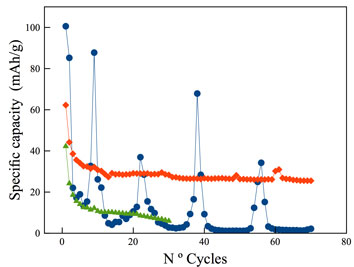Crossref Citations
This article has been cited by the following publications. This list is generated based on data provided by
Crossref.
Kanagaraj, Amarsingh Bhabu
Al Shibli, Hamda
Alkindi, Tawaddod Saif
Susantyoko, Rahmat Agung
An, Boo Hyun
AlMheiri, Saif
AlDahmani, Sultan
Fadaq, Hamed
and
Choi, Daniel S.
2018.
Hydrothermal synthesis of LiFePO4 micro-particles for fabrication of cathode materials based on LiFePO4/carbon nanotubes nanocomposites for Li-ion batteries.
Ionics,
Vol. 24,
Issue. 11,
p.
3685.
Honggowiranto, Wagiyo
Ja’farawy, Muhammad Shalahuddin al
and
Sudaryanto
2021.
Preparation of yttrium doped lithium iron(II) phosphate as cathode material using solid state reaction.
Vol. 2381,
Issue. ,
p.
020021.
Sadil, Jindřich
Kekula, František
Majera, Juraj
and
Pisharodi, Vivek
2022.
Comparison of Capacity Fade for the Constant Current and WLTC Drive Cycle Discharge Modes for Commercial LiFeYPO4 Cells Used in xEV Vehicles.
Batteries,
Vol. 8,
Issue. 12,
p.
282.
Ho, Chang Won
Shaji, Nitheesha
Kim, Hong Ki
Park, Jae Woo
Nanthagopal, Murugan
and
Lee, Chang Woo
2022.
Thermally assisted conversion of biowaste into environment-friendly energy storage materials for lithium-ion batteries.
Chemosphere,
Vol. 286,
Issue. ,
p.
131654.
Zheng, Jiawei
Yang, Jianwen
Wu, Jinmei
Li, Shengxian
Wang, Mengwen
Huang, Bin
Li, Yanwei
Xiao, Shunhua
and
Zhu, Qing
2023.
Y3+ doping and electrochemical properties of LiFe0.5Mn0.5PO4@C cathode material for lithium-ion batteries.
Journal of Alloys and Compounds,
Vol. 960,
Issue. ,
p.
170610.
Al Shibli, Hamda
Chaturvedi, Prerna
Kanagaraj, Amarsingh Bhabu
Zaghari, Pouria
Choi, Daniel S
and
Ryu, Jong Eun
2024.
Sol-gel fabricated one-dimensional LiFePO4 microstructures for carbon nanotube-based nanocomposite freestanding sheet as cathode material for Li ion batteries.
Journal of Composite Materials,
Vol. 58,
Issue. 4,
p.
435.
